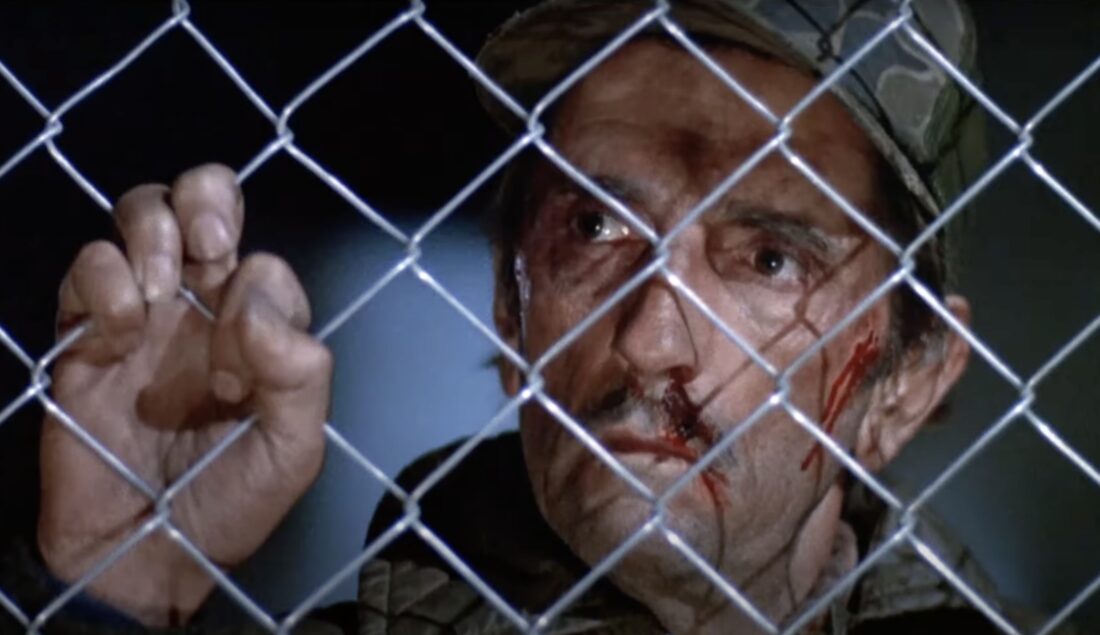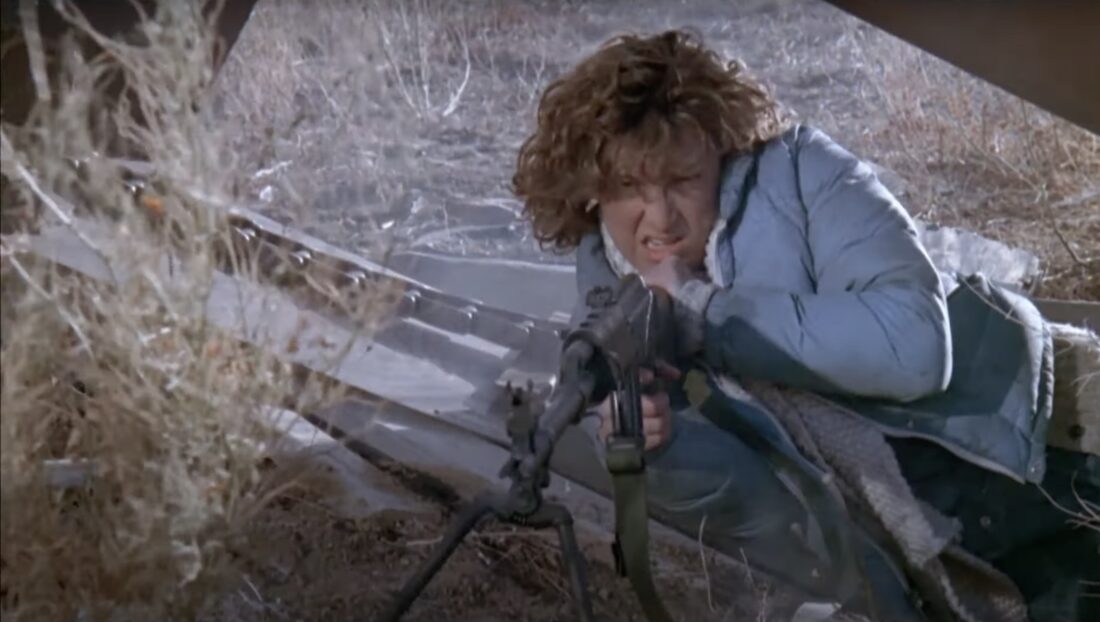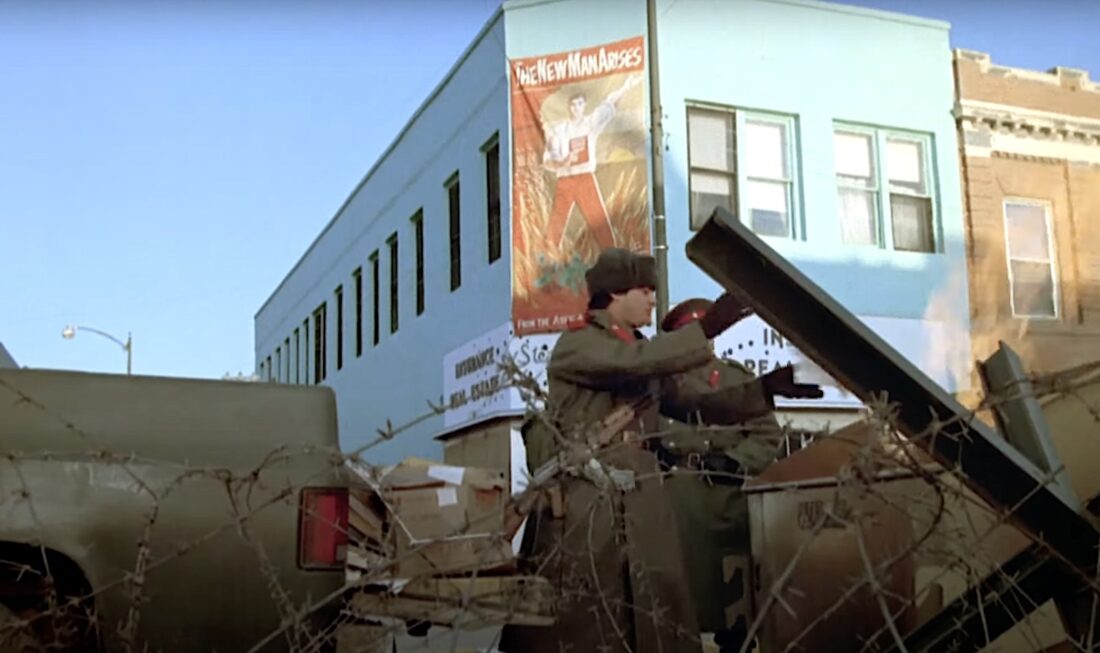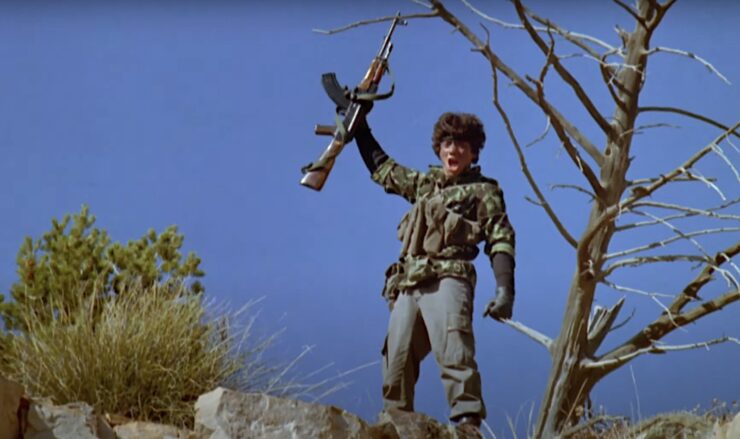American pop culture can be inspiring. Hopefully, it inspires the right people.
Popeye the Sailor Man served as the mascot of an Anarchist group during the Spanish Civil War. Pro-democracy demonstrators in Thailand in 2014 and Myanmar in 2021 employed the three-fingered salute from The Hunger Games. And in April 2022, a photograph from Ukraine circulated on social media: a downed Russian tank spray-painted with a single word in English, “Wolverines.” It was a reference to John Milius’ Red Dawn, a classic of the late Cold War.
Red Dawn, which enjoyed massive box office success upon its release 40 years ago in August 1984, tells the story of an insurgent group of teenagers who resist the Soviet invasion of a fictional small town in Colorado. The Wolverines’ guerilla tactics are more Việt Cộng than U.S. Army, but with a name taken from the high school football team, they’re true children of the Mountain West. It was one of many youth-oriented films of the 1980s and it featured several soon-to-be stars, among them Patrick Swayze—the Wolverines’ leader Jed—Charlie Sheen, Jennifer Grey, and Lea Thompson. But it was no romp. If anything, the film was anchored by the melancholic veteran character actors in supporting roles, among them Harry Dean Stanton, Ben Johnson, and Powers Boothe.
The Ukrainian fighters’ identification with the Wolverines is poignant not only for what it says about the Ukrainians but also for what it suggests about the film’s American audience. “Red Dawn” is a verb in our lexicon, as in “I’m going to Red Dawn your ass,” and the film’s admirers include libertarian and pro-gun intellectuals. If you look closely, however, you will see that the film’s narrative does not differ all that much from the mainstream media coverage of the war in Ukraine. It is an encapsulation of how Americans talk about war in general, both the wars we fight ourselves, as well as the causes we support with either our soft power or our treasure.
* * *
Milius was a friend and collaborator of New Hollywood’s auteurs. He had written a draft of Apocalypse Now—his favorite pastime is said to have influenced the surfing sequence—and offered informal advice during the shooting of Jaws that led to Quint’s iconic speech about the U.S.S. Indianapolis. Like Steven Spielberg, Francis Ford Coppola, and George Lucas, he was a child of the 1960s—but not their ’60s. He called himself a “frustrated fighter pilot,” whose attempt to enlist during the Vietnam War was thwarted by his asthma. And his aesthetic was hyper-masculine and ultra-violent; Conan the Barbarian, his previous film, was almost rated X. He was an avid collector of firearms; Darren Dalton, who played one of the Wolverines, described him to me as “a teddy bear with a machine gun.” According to a not quite substantiated rumor, the Coen brothers used Milius as the inspiration for John Goodman’s Walter Sobchak in The Big Lebowski.
The audiences may have loved Red Dawn, but the critics were hostile. One predicted the movie would be remembered solely as the first to obtain a PG-13 rating—inappropriate for pre-teens, even as it catered to an adolescent appetite for blood and guns. Another wrote, “If only Milius’ narrative were as clear as his right-wing sentiments.” The New York Times’ Janet Maslin called it “rabidly inflammatory.”

Milius met the criticism with good humor, and he charmed one journalist with a joking self-caricature: “the Hermann Göring of the cinema.” He defended Red Dawn as anti-war in spirit, a study of how armed conflict dehumanizes both the occupier and the occupied. In the film, the Soviets establish Stalinist camps, but their Central American allies, former insurgents themselves, face a crisis of conscience and are genuinely sympathetic to the small-town Americans. The souls of Milius’ baby-faced heroes, meanwhile, are diminished with every life they take.
C. Thomas Howell, who had starred as Ponyboy Curtis in The Outsiders, plays Robert, one of the most memorable of the Wolverines. He first appears wearing a Star Wars baseball cap, but after the Soviets leave him an orphan, he gives up on fantasy and transforms into a cold-blooded killer, eager to wear camouflage, indifferent to his enemies’ pain. He is an embodiment of the fears of Eugene, an I.T. worker from Kharkiv, whom The Daily interviewed for an episode which aired on March 1, 2022.
Eugene lived a normal life before the invasion. He shopped for PlayStation games, brought baked goods into his office. The media reports of Ukraine’s early victories did not bring him joy, as he saw in them records of the deaths of young men who just happened to be born in Vladimir Putin’s Russia. “Every time we’re winning, somebody losing a father, son, friend.” He had never killed anyone in his life, but he was now researching a specific kind of Molotov cocktail, one with an additional ingredient that caused severe burns if it contacted skin. He imagined the situation that would lead him to use that weapon. “I will have psychological circumstances after that,” he said. “But what other choice do I have?”
While Eugene was trying to adjust to a new conception of himself as an annihilator of human lives, the American public became jingoistic cheerleaders. A full year into the conflict, in February 2023, Malcolm Nance, a counterterrorist expert who had fought for the Ukrainian Foreign Legion, appeared on Real Time with Bill Maher, where he bragged about kicking Russia’s ass to the cheers of the studio audience. I hope even now, two-and-a-half years in, as the war settles into attrition, and as Volodymyr Zelensky reveals himself to be an at-best imperfect protector of democratic norms, that North America and Europe continue to aid the Ukrainian people.
I also know that war isn’t football.
We are confused, as were Milius and his critics. Is Red Dawn really anti-war? Is it a study of trauma? A celebration of everything that leads to trauma?
War is not a game, we say, even as we practice war games. There’s nothing heroic about war; every soldier is a hero. There are rules in warfare; war is crime.
* * *
You can debate the politics of Red Dawn, but if it has one, unambiguous policy message, it is a broad interpretation of the Second Amendment. In an early scene, the Soviets obtain a registration list from the local library in order to confiscate the Americans’ firearms, a dramatization of a dystopian scenario often described by gun rights activists.
For Milius, though, guns were as recreational as they were necessary. According to Dalton, Milius would fire a machine gun instead of yelling “Action!” and “Cut!” If he was frustrated on set—Doug Toby, another cast member, told me—he would pull out a pistol, shoot a few blanks, then settle down and drink a Pepto Bismol. (Toby appears in the film’s most famous scene, holding a rifle aloft and shouting “Wolverines!”) One night, he offered to drive Howell back to the hotel. “Here we were speeding down the road and he screeches to a halt, leaps out and fires six rounds into a Stop sign out in the middle of nowhere. And he hopped back and he looks at me and says, ‘That felt so good.’”
“I don’t think we would have flinched if John came to set decked out in bandoliers with an RPG over his shoulder,” Dalton wrote me. “He was enjoying his opportunity to lead like General Patton as much as we loved going to battle for him.”
At the beginning of the shoot, he gathered his main cast into a room. “He lined us all up and in sort of a drill sergeant manner,” Howell says. “John sort of exuded a militaristic aura. He looked us all in the eye and said, ‘Men,’—of course there were two women there—‘when I hired you I didn’t hire any pussies. I want to take the next half hour answering questions about your characters and after that I don’t want to hear another word about it.’”
Milius took his core cast to a gun range, where they learned the basics of shooting. The actors needed to know the feel of a gun in their hands, the feel of a kickback. Apparently, this was his version of playing an acting coach. “Which weapon is right for your character?” he asked them at the end.
Not everyone enjoyed the atmosphere. In her memoir, Jennifer Grey called the film “right-wing propaganda” but also her opportunity to play a “badass guerilla fighter.” It was a boys’ club, and she did not much appreciate the pranks. Her castmates, among them Howell and Sheen, had set off firecrackers outside her hotel room in Las Vegas, New Mexico, where the movie was filmed, and she mistook the sounds for gunshots.

The young actors trained under the guidance of former mercenaries, Green Berets, and Navy Seals. “There was a learned skill of being in those situations where you have to maintain your senses,” says Toby. “People are coming at you, around you. It’s a freak-out moment. And you have to move calmly, in a thoughtful manner.” The Wolverines, of course, are not highly trained Green Berets, but young boys striving and working towards that mindset. The evolution of Howell’s Robert into a killing machine is a tragedy.
The Wolverines’ first battle is the most dramatically interesting. The inexperienced teenagers miss their targets, scurry along the mountain, barely know how to hold a gun or a bow-and-arrow. The scene is fun and genuinely scary, but also the first step the young boys take down a dark road from which they will not return. The Wolverines take no prisoners. The scene ends with Swayze’s Jed executing a Russian soldier, who turns away from his pistol. Milius may have loved guns, but he knew why they had been invented.

Milius indulges world-building humor—the movie theater in the occupied town plays Alexander Nevsky and the Soviets set up their own canteen—but, at heart, the film is responsible enough to be depressing. In some ways, it’s more responsible than the anti-war Vietnam films of the 1970s and ’80s. Coppola may have intended the opening sequence in Apocalypse Now, in which the sound of helicopters and The Doors merge over napalm and Martin Sheen’s real-life breakdown, as an evocation of the psychosis of modern warfare, but viewers have long grooved to his tone poem.
The Wolverines die brutally. Howell’s Robert commits suicide by willingly exposing himself to enemy fire. The boys execute Dalton’s Daryl when he is exposed as a traitor. My older brother was shaken when he saw the film on cable a few years after its release, when he was a pre-teen. I was shaken too when I saw it earlier this year for the first time. Unlike his previous collaborators, Milius was not an artful filmmaker; his action scenes are smart but they lack rhythm, and his indulgence of Greatest Generation-style iconography, including Basil Poledouris’ drumbeat heavy score, is unintentionally funny. But other than Spielberg, he is one of the few mainstream directors to communicate the atrocity inherent in the death of a child.
* * *
There are many factors—economic, social, and cultural—that lead teenagers to join the U.S. military. More than a few will cite movies, and Red Dawn is one of several Reagan-era entertainments that influenced a generation of young men to later serve in the Gulf War and the War on Terror. Others on the list include G.I. Joe and Top Gun. An ex-Marine once told me he had been attracted by the firm, proud posture of the soldiers in Full Metal Jacket.
Of them all, Red Dawn captures the contradiction between rhetoric and experience, and permits its viewers to hate combat while still indulging a love for adventure. Even in the era of modern warfare, whether they be members of the occupying force or the occupied, the argument—the argument each of us has with ourself, is the same. “But if it be a sin to covet honour, I am the most offending soul alive,” says Henry V, as he rouses his “band of brothers” to take France. His old companion is more cynical. “What is honour?” asks Falstaff. “A word. What is in that word honour? What is that honour? Air.”










